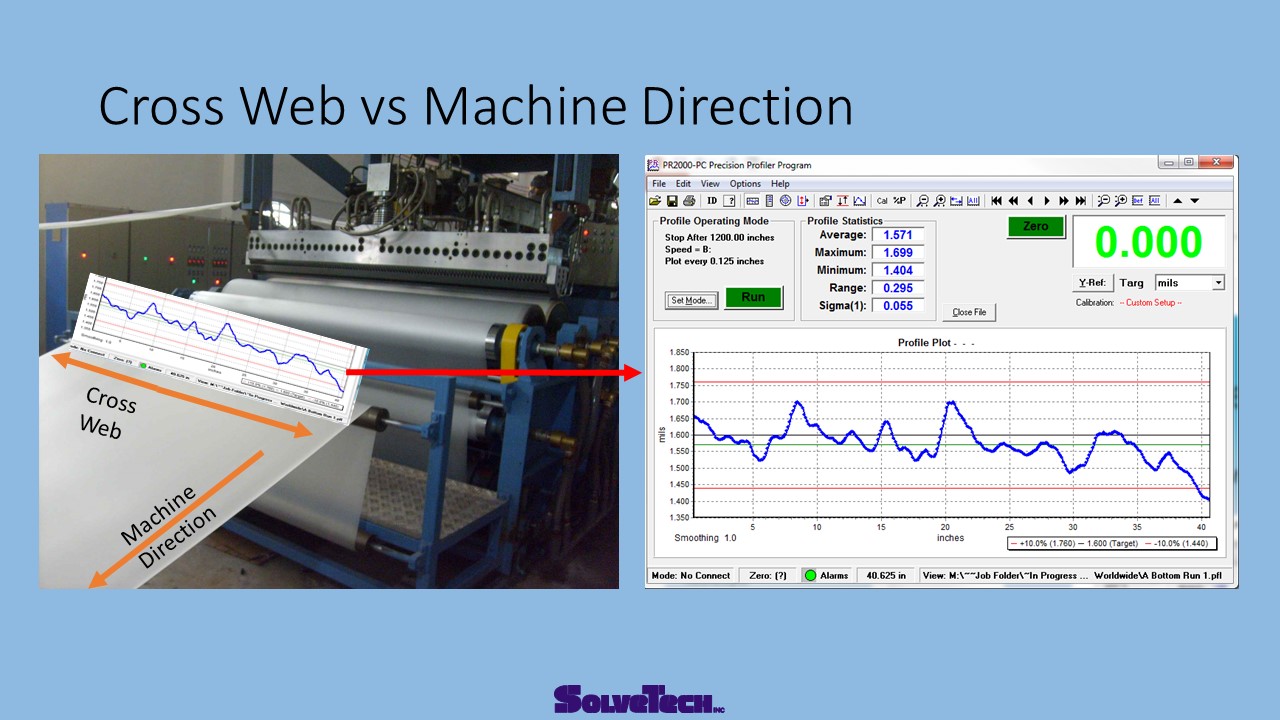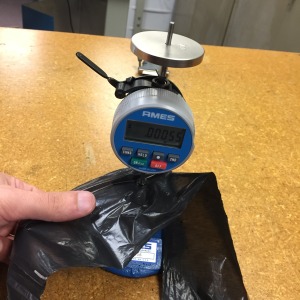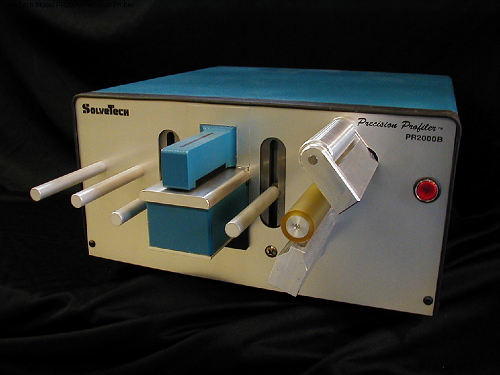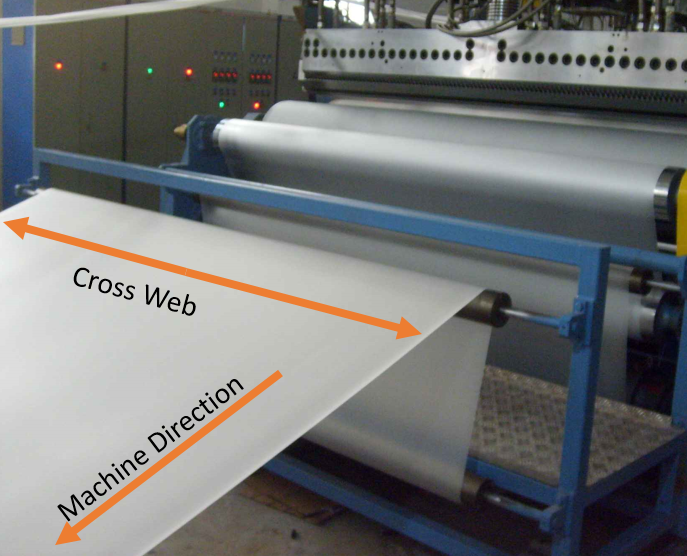如何测量塑料薄膜的厚度?
[/highlight]

这篇文章是为了教会大家用不同的方法来测量塑料薄膜的厚度。如果您有任何问题,可以联系我们。
If you have any questions, feel free to contact us here.
我们通常是测量薄膜的横向和纵向,即穿越薄膜的方向和机器滚动的方向,来观察产品生产过程中的表现。依据生产的条件,薄膜的表现也不一样。
在测量薄膜过程中,有一些独特的挑战。这里有一些工具可以帮助您。点击这里ASTM 标准利用螺旋测微器来测量塑料薄膜。
当我们像以下展示的那样,在线或用实验测量薄膜的厚度,这里有一些不同的问题需要思考。
像塑料一样薄的厚度,您需要准确的工具来得到精确的答案。您会发现也能应用这些信息来测量其它薄的材料。
Off Line 离线实验厚度测量:
实验室测量是质量控制的第一步 许多塑料薄膜的生产商和买家出于购买或质量的考虑会想要测量薄膜的厚度。 平均厚度可以用密度,重量和一片薄膜的横截面来测量。 为了得到薄膜的可变性,您需要测量薄膜上不同的点来观测薄膜的变量。
在这里,我们有专门的工具来满足客户的需求。
接触式测量:
[/highlight]
接触式测量是一种简单易懂的方式,但是有一些缺点。螺旋测微器在实验室中用来测量厚度是相当容易的,但是精确性不容乐观。
优点:
- 简单易用
- 价格优惠
缺点:
- 对于薄膜而言,解析度太低(0.05 mils for a 0.5 mil film gives +/- 10% error)
需要花费很多时间测量不同的点
在薄膜上测量有不可重复性
在测量平均厚度或者是获取剖面上不具有现实意义
ASTM 标准 D6988 描述了利用净重卡尺
Additionally, a surface finish on a film will typically give a micrometer an error. Usually it will skew the reading high because the device will rest of the peaks of the rough surface.
Non Contact Gauging

For most plastic films and especially thin films, non contacting gauging is the method of choice to get an accurate and quick reading. Many capacitance gauging systems are set up as profilers, such as SolveTech’s PR2000 Precision Profiler. Profilers are helpful because they can provide a picture of the film thickness across the web or in the machine direction. You can bypass the calipers by calibrating based on the average thickness of a strip. This is known as the gauge by weight method and it is built into the PR2000 software.

Capacitance is the preferred method for the following reasons:
- Repeatable and Accurate to 0.001 mils
- Will pick up almost all defects with high resolution
- Measures a samples quickly and easily which saves time and money.
- Can accurately deliver the average material thickness while showing the variability profile
Drawbacks:
- Higher cost initial cost than a micrometer
- Calibration can be required
Capacitance technology will tell you the overall thickness of the material you are trying to measure. However, coating thickness can still be measured if you are able to measure the material before the coating is applied and after the coating is applied. You can then do a subtraction of the before and after to get the delta.
There are other technologies on the market that can be helpful when trying to read individual film layers using NIR for example. Capacitance has a drawback in that it can’t measure conductive materials and it can also be sensitive to variation in moisture levels.
On Line Thickness Gauging
Measuring on line is a great tool for monitoring your quality in real time. Catching an error can help reduce waste and improve the products you are producing. Additionally, producers can sometimes down gauge their average thickness if they produce a more uniform film. A thin spot in the film is like the weakest link in a chain, so if it is eliminated, the film becomes stronger overall. Down gauging can save some producers a great deal of money in material costs.
In many cases, live feedback control is used to help make automatic adjustments to the extruder. Contact gauging is typically not practical in this case due to the high speed of the line, so non contacting methods have been widely adopted.
It is important to understand some key concepts for on line gauging, and different processes will have some different needs. You can measure both in the machine direction and in the cross web direction. Cross web measurements are more typical, but machine direction gauging is gaining in popularity.
There are several styles of blown film production equipment: no rotation, and oscillating die, and an oscillating haul off.
For on line gauging, there are two basic methods, on the bubble gauging, and gauging after the lay flat. To learn more, read our article “The Impact of Thickness Gauging on a Blown Film Plant”
On The Bubble
Thickness gauges that measure on the bubble are used to provide the thickness of the film as it is being produced. They typically use a capacitance based technology, although it is different the technology SolveTech uses for it’s capacitance gauging systems. These systems scan the bubble using a circular slide and give a relative measurement, meaning that they measure the variability across the web. They have difficulty measuring absolute thickness because they have trouble holding calibration.
They are however popular on many blown film lines because they can provide feed back control to the die. If the density is known, they can use gravimetric control to calculate the average thickness. However, in practice, the exact density is not always known or entered correctly, and the dimensions of the bubble also have to be considered. Some blown film companies also find these machines to be complex to operate and maintain.
After the Lay Flat
A simpler and lest costly approach is to measure the thickness after the lay flat, meaning after the bubble is collapsed. SolveTech’s BF200 measures material after the lay flat using a spot along the edge or both edges. If either the die or the haul off is rotating, the system can map the entire bubble by measuring one point along the edge. This is because the bubble profile will rotate through this one point over time, and the rotation speed can be tracked.

Besides being simpler to operate and more economical, these systems are easily retrofitable to existing blown film lines and can hold calibration for an absolute measurement.
The disadvantages are that there is more process time between the creation of the material and when it is measured, and if there is no rotation on the line, you can not get a bubble profile. There can also be some challenges when doing feedback control when using a oscillating haul off. This is because twisting of the bubble can distort the profile.
Overall, these systems have been widely adopted, and SolveTech is a leader in this area with well over 150 installed.
Cast Film Gauging
For cast film, producers will often measure thickness across the web and make adjustments to their die accordingly. For wide webs, many customers will use a scanning gauge of some kind. Scanning gauges take a measurement head to scan it back and forth across the web to create a thickness profile. Some typically technologies include x-ray, gamma backscatter and beta ray gauges. There are also some capacitance based technologies and optical technologies that are used. For measuring a coating thickness, NIR or Near Infrared is popular.
For narrow webs less than 60 inches, many producers use a C Channel capacitance gauging system. SolveTech offers our unique Multichannel which does not scan and instead offers full and contact coverage of the web using multiple channels. This system has been widely adopted as the standard in narrow web since it has superior performance to the other scanning gauge technologies, and it can give a high percentage of coverage.

Biax Film Gauging
Biaxial Film is stretched in two directions. Therefore, along with measuring the cross web like in cast film, it may be important for the producer to measure the thickness variability in the machine direction. This is a SolveTech specialty due to our unique gauge design, and for more information, you can visit our page on machine direction gauging.
In summary, there are several methods available to measure plastic film thickness, and the one you select depends on your need and process. You can learn more about what thickness gauging can do for a blown plant here.
For more information on thickness gauging for plastic film, please contact us at info@gauging.com and we would be happy to answer your questions.
How to Measure Plastic Film | Plastics Film Thickness Gauging | Measure Plastic Film Thickness


